BUS854 Report: Cultural Impacts on Business Across Countries
VerifiedAdded on 2023/06/04
|27
|6304
|242
Report
AI Summary
This research report examines the impacts of culture on international business, focusing on the USA, Australia, and Nepal. It highlights the importance of managing cultural differences for achieving competitive advantages in the global market. The report analyzes various factors, including negotiation styles, workplace etiquette, and organizational hierarchy, using Hofstede's dimensions to understand cultural nuances. It also addresses potential challenges arising from cultural differences, such as pricing issues and communication barriers, and emphasizes the need for cross-cultural awareness. The research employs a methodology suitable for gathering data on cultural impacts and acknowledges the limitations of the study, providing a comprehensive overview of how cultural factors influence business operations across different countries. Desklib provides more resources for students, including past papers and solved assignments.

Running Head: Managing Cultural Diversity 1
Managing Cultural Diversity
Managing Cultural Diversity
Paraphrase This Document
Need a fresh take? Get an instant paraphrase of this document with our AI Paraphraser
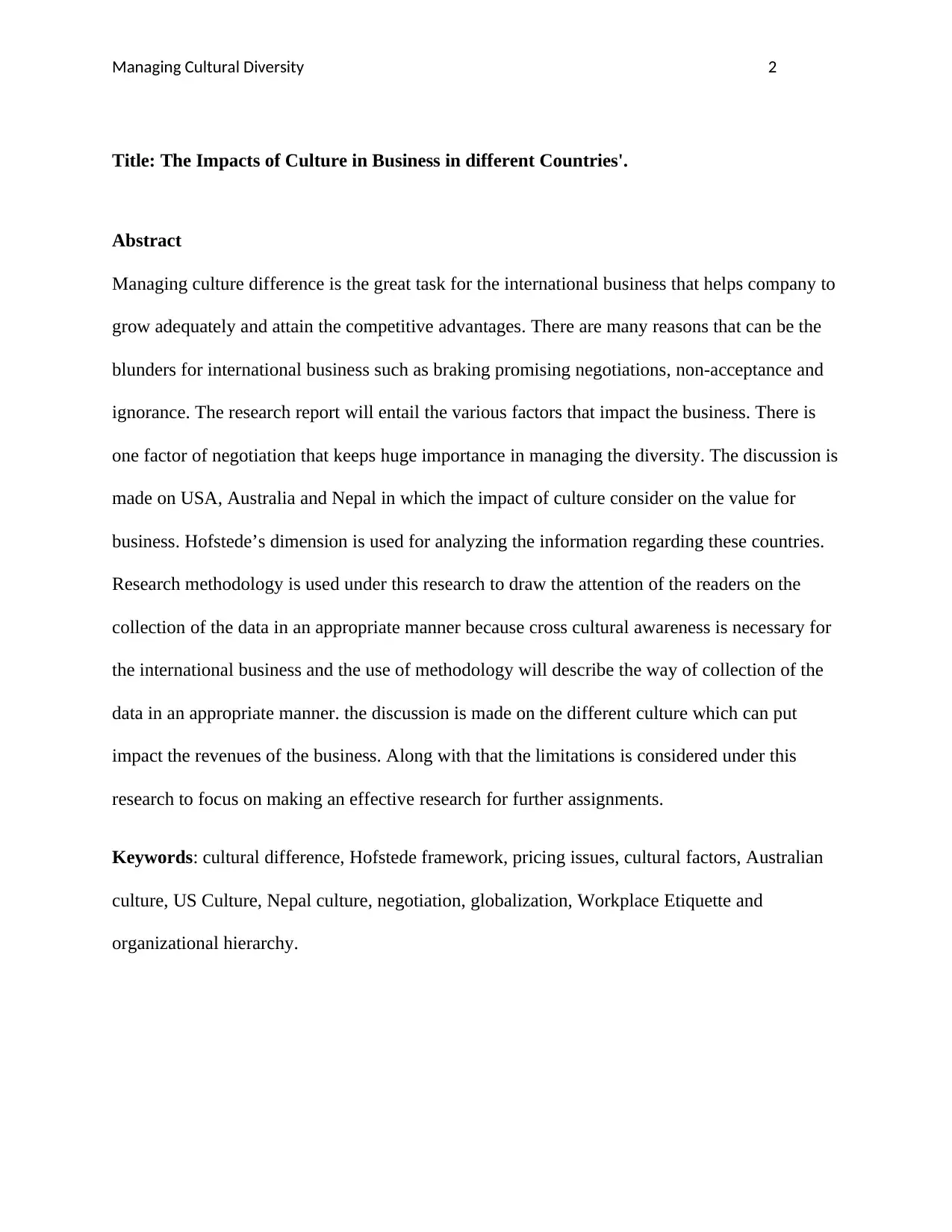
Managing Cultural Diversity 2
Title: The Impacts of Culture in Business in different Countries'.
Abstract
Managing culture difference is the great task for the international business that helps company to
grow adequately and attain the competitive advantages. There are many reasons that can be the
blunders for international business such as braking promising negotiations, non-acceptance and
ignorance. The research report will entail the various factors that impact the business. There is
one factor of negotiation that keeps huge importance in managing the diversity. The discussion is
made on USA, Australia and Nepal in which the impact of culture consider on the value for
business. Hofstede’s dimension is used for analyzing the information regarding these countries.
Research methodology is used under this research to draw the attention of the readers on the
collection of the data in an appropriate manner because cross cultural awareness is necessary for
the international business and the use of methodology will describe the way of collection of the
data in an appropriate manner. the discussion is made on the different culture which can put
impact the revenues of the business. Along with that the limitations is considered under this
research to focus on making an effective research for further assignments.
Keywords: cultural difference, Hofstede framework, pricing issues, cultural factors, Australian
culture, US Culture, Nepal culture, negotiation, globalization, Workplace Etiquette and
organizational hierarchy.
Title: The Impacts of Culture in Business in different Countries'.
Abstract
Managing culture difference is the great task for the international business that helps company to
grow adequately and attain the competitive advantages. There are many reasons that can be the
blunders for international business such as braking promising negotiations, non-acceptance and
ignorance. The research report will entail the various factors that impact the business. There is
one factor of negotiation that keeps huge importance in managing the diversity. The discussion is
made on USA, Australia and Nepal in which the impact of culture consider on the value for
business. Hofstede’s dimension is used for analyzing the information regarding these countries.
Research methodology is used under this research to draw the attention of the readers on the
collection of the data in an appropriate manner because cross cultural awareness is necessary for
the international business and the use of methodology will describe the way of collection of the
data in an appropriate manner. the discussion is made on the different culture which can put
impact the revenues of the business. Along with that the limitations is considered under this
research to focus on making an effective research for further assignments.
Keywords: cultural difference, Hofstede framework, pricing issues, cultural factors, Australian
culture, US Culture, Nepal culture, negotiation, globalization, Workplace Etiquette and
organizational hierarchy.

Managing Cultural Diversity 3
⊘ This is a preview!⊘
Do you want full access?
Subscribe today to unlock all pages.

Trusted by 1+ million students worldwide
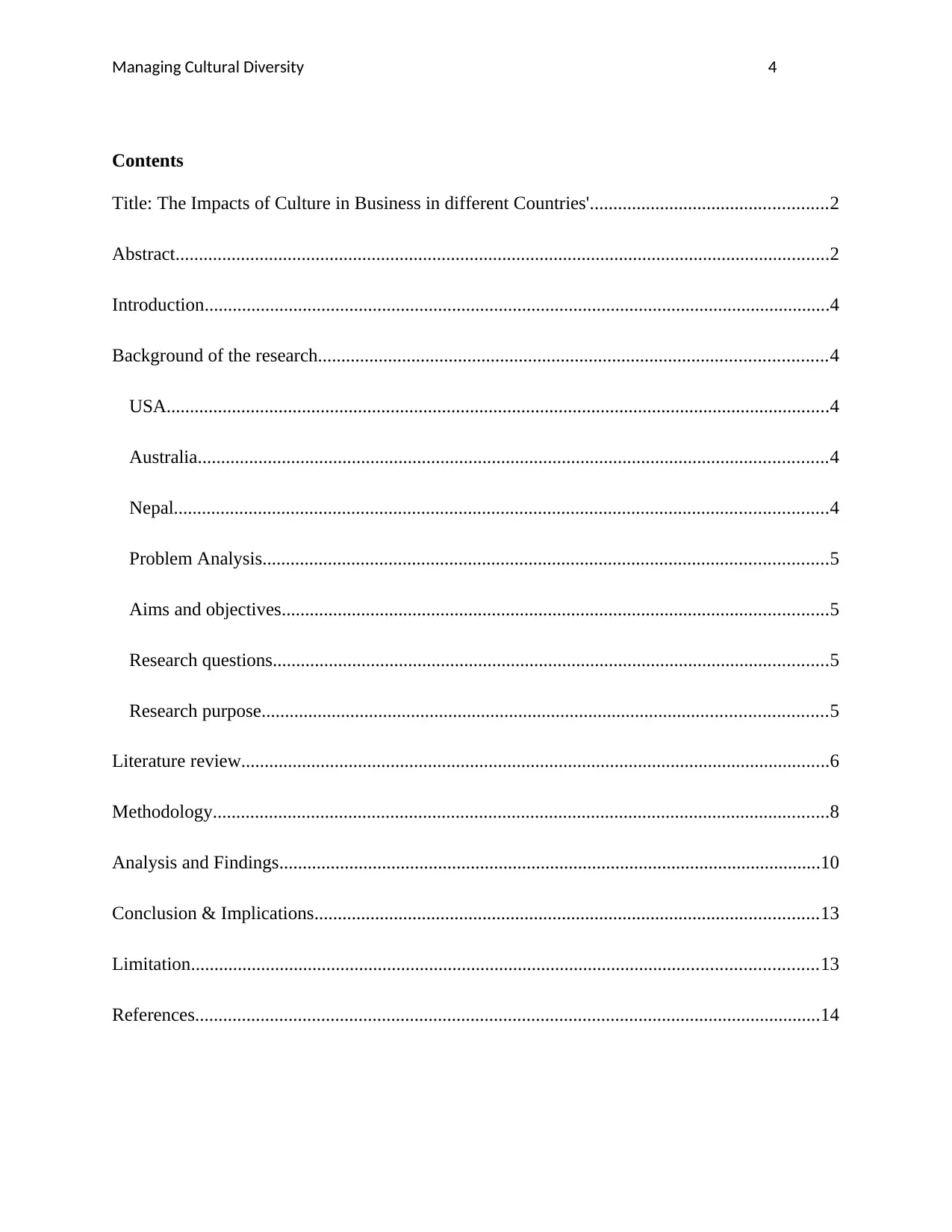
Managing Cultural Diversity 4
Contents
Title: The Impacts of Culture in Business in different Countries'...................................................2
Abstract............................................................................................................................................2
Introduction......................................................................................................................................4
Background of the research.............................................................................................................4
USA..............................................................................................................................................4
Australia.......................................................................................................................................4
Nepal............................................................................................................................................4
Problem Analysis.........................................................................................................................5
Aims and objectives.....................................................................................................................5
Research questions.......................................................................................................................5
Research purpose.........................................................................................................................5
Literature review..............................................................................................................................6
Methodology....................................................................................................................................8
Analysis and Findings....................................................................................................................10
Conclusion & Implications............................................................................................................13
Limitation......................................................................................................................................13
References......................................................................................................................................14
Contents
Title: The Impacts of Culture in Business in different Countries'...................................................2
Abstract............................................................................................................................................2
Introduction......................................................................................................................................4
Background of the research.............................................................................................................4
USA..............................................................................................................................................4
Australia.......................................................................................................................................4
Nepal............................................................................................................................................4
Problem Analysis.........................................................................................................................5
Aims and objectives.....................................................................................................................5
Research questions.......................................................................................................................5
Research purpose.........................................................................................................................5
Literature review..............................................................................................................................6
Methodology....................................................................................................................................8
Analysis and Findings....................................................................................................................10
Conclusion & Implications............................................................................................................13
Limitation......................................................................................................................................13
References......................................................................................................................................14
Paraphrase This Document
Need a fresh take? Get an instant paraphrase of this document with our AI Paraphraser

Managing Cultural Diversity 5
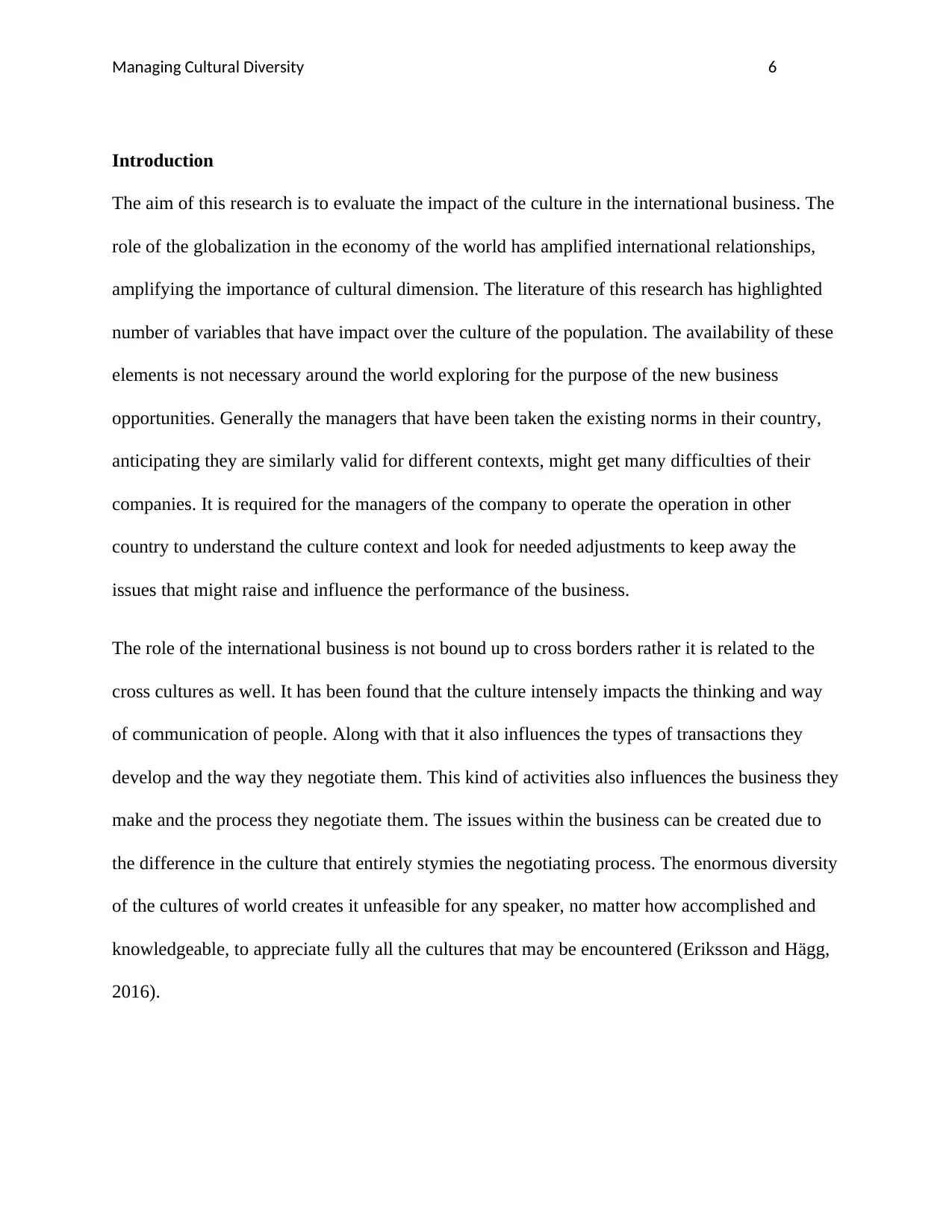
Managing Cultural Diversity 6
Introduction
The aim of this research is to evaluate the impact of the culture in the international business. The
role of the globalization in the economy of the world has amplified international relationships,
amplifying the importance of cultural dimension. The literature of this research has highlighted
number of variables that have impact over the culture of the population. The availability of these
elements is not necessary around the world exploring for the purpose of the new business
opportunities. Generally the managers that have been taken the existing norms in their country,
anticipating they are similarly valid for different contexts, might get many difficulties of their
companies. It is required for the managers of the company to operate the operation in other
country to understand the culture context and look for needed adjustments to keep away the
issues that might raise and influence the performance of the business.
The role of the international business is not bound up to cross borders rather it is related to the
cross cultures as well. It has been found that the culture intensely impacts the thinking and way
of communication of people. Along with that it also influences the types of transactions they
develop and the way they negotiate them. This kind of activities also influences the business they
make and the process they negotiate them. The issues within the business can be created due to
the difference in the culture that entirely stymies the negotiating process. The enormous diversity
of the cultures of world creates it unfeasible for any speaker, no matter how accomplished and
knowledgeable, to appreciate fully all the cultures that may be encountered (Eriksson and Hägg,
2016).
Introduction
The aim of this research is to evaluate the impact of the culture in the international business. The
role of the globalization in the economy of the world has amplified international relationships,
amplifying the importance of cultural dimension. The literature of this research has highlighted
number of variables that have impact over the culture of the population. The availability of these
elements is not necessary around the world exploring for the purpose of the new business
opportunities. Generally the managers that have been taken the existing norms in their country,
anticipating they are similarly valid for different contexts, might get many difficulties of their
companies. It is required for the managers of the company to operate the operation in other
country to understand the culture context and look for needed adjustments to keep away the
issues that might raise and influence the performance of the business.
The role of the international business is not bound up to cross borders rather it is related to the
cross cultures as well. It has been found that the culture intensely impacts the thinking and way
of communication of people. Along with that it also influences the types of transactions they
develop and the way they negotiate them. This kind of activities also influences the business they
make and the process they negotiate them. The issues within the business can be created due to
the difference in the culture that entirely stymies the negotiating process. The enormous diversity
of the cultures of world creates it unfeasible for any speaker, no matter how accomplished and
knowledgeable, to appreciate fully all the cultures that may be encountered (Eriksson and Hägg,
2016).
⊘ This is a preview!⊘
Do you want full access?
Subscribe today to unlock all pages.

Trusted by 1+ million students worldwide
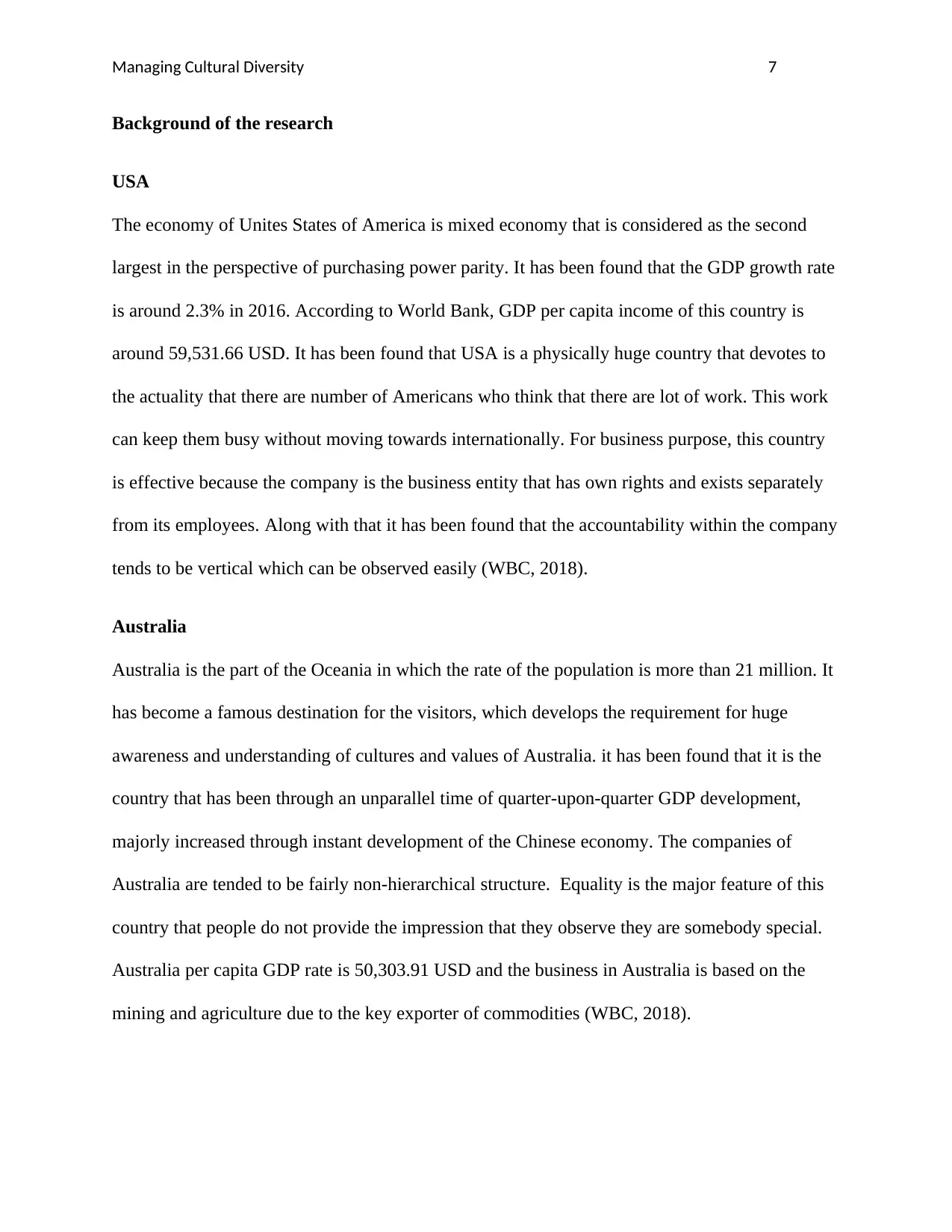
Managing Cultural Diversity 7
Background of the research
USA
The economy of Unites States of America is mixed economy that is considered as the second
largest in the perspective of purchasing power parity. It has been found that the GDP growth rate
is around 2.3% in 2016. According to World Bank, GDP per capita income of this country is
around 59,531.66 USD. It has been found that USA is a physically huge country that devotes to
the actuality that there are number of Americans who think that there are lot of work. This work
can keep them busy without moving towards internationally. For business purpose, this country
is effective because the company is the business entity that has own rights and exists separately
from its employees. Along with that it has been found that the accountability within the company
tends to be vertical which can be observed easily (WBC, 2018).
Australia
Australia is the part of the Oceania in which the rate of the population is more than 21 million. It
has become a famous destination for the visitors, which develops the requirement for huge
awareness and understanding of cultures and values of Australia. it has been found that it is the
country that has been through an unparallel time of quarter-upon-quarter GDP development,
majorly increased through instant development of the Chinese economy. The companies of
Australia are tended to be fairly non-hierarchical structure. Equality is the major feature of this
country that people do not provide the impression that they observe they are somebody special.
Australia per capita GDP rate is 50,303.91 USD and the business in Australia is based on the
mining and agriculture due to the key exporter of commodities (WBC, 2018).
Background of the research
USA
The economy of Unites States of America is mixed economy that is considered as the second
largest in the perspective of purchasing power parity. It has been found that the GDP growth rate
is around 2.3% in 2016. According to World Bank, GDP per capita income of this country is
around 59,531.66 USD. It has been found that USA is a physically huge country that devotes to
the actuality that there are number of Americans who think that there are lot of work. This work
can keep them busy without moving towards internationally. For business purpose, this country
is effective because the company is the business entity that has own rights and exists separately
from its employees. Along with that it has been found that the accountability within the company
tends to be vertical which can be observed easily (WBC, 2018).
Australia
Australia is the part of the Oceania in which the rate of the population is more than 21 million. It
has become a famous destination for the visitors, which develops the requirement for huge
awareness and understanding of cultures and values of Australia. it has been found that it is the
country that has been through an unparallel time of quarter-upon-quarter GDP development,
majorly increased through instant development of the Chinese economy. The companies of
Australia are tended to be fairly non-hierarchical structure. Equality is the major feature of this
country that people do not provide the impression that they observe they are somebody special.
Australia per capita GDP rate is 50,303.91 USD and the business in Australia is based on the
mining and agriculture due to the key exporter of commodities (WBC, 2018).
Paraphrase This Document
Need a fresh take? Get an instant paraphrase of this document with our AI Paraphraser
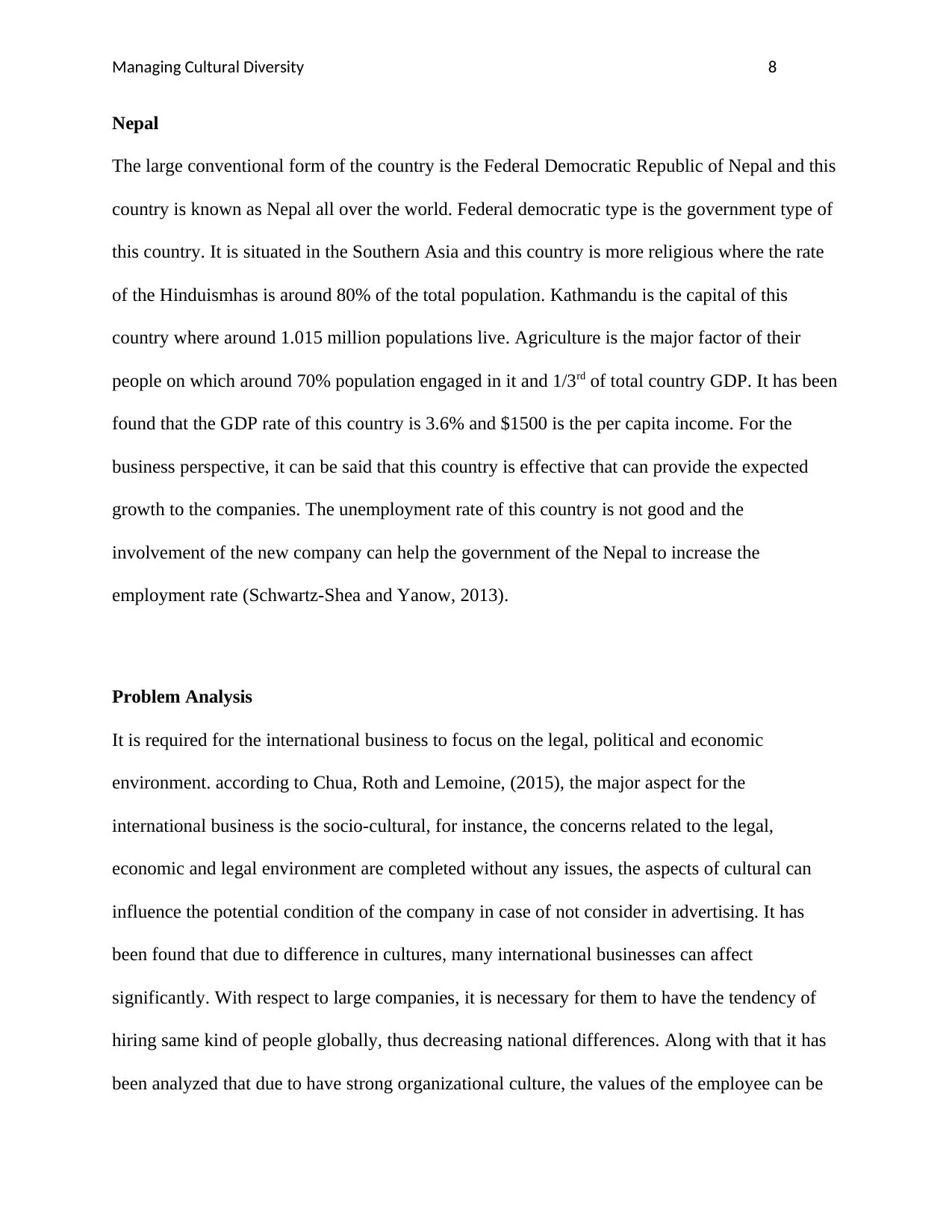
Managing Cultural Diversity 8
Nepal
The large conventional form of the country is the Federal Democratic Republic of Nepal and this
country is known as Nepal all over the world. Federal democratic type is the government type of
this country. It is situated in the Southern Asia and this country is more religious where the rate
of the Hinduismhas is around 80% of the total population. Kathmandu is the capital of this
country where around 1.015 million populations live. Agriculture is the major factor of their
people on which around 70% population engaged in it and 1/3rd of total country GDP. It has been
found that the GDP rate of this country is 3.6% and $1500 is the per capita income. For the
business perspective, it can be said that this country is effective that can provide the expected
growth to the companies. The unemployment rate of this country is not good and the
involvement of the new company can help the government of the Nepal to increase the
employment rate (Schwartz-Shea and Yanow, 2013).
Problem Analysis
It is required for the international business to focus on the legal, political and economic
environment. according to Chua, Roth and Lemoine, (2015), the major aspect for the
international business is the socio-cultural, for instance, the concerns related to the legal,
economic and legal environment are completed without any issues, the aspects of cultural can
influence the potential condition of the company in case of not consider in advertising. It has
been found that due to difference in cultures, many international businesses can affect
significantly. With respect to large companies, it is necessary for them to have the tendency of
hiring same kind of people globally, thus decreasing national differences. Along with that it has
been analyzed that due to have strong organizational culture, the values of the employee can be
Nepal
The large conventional form of the country is the Federal Democratic Republic of Nepal and this
country is known as Nepal all over the world. Federal democratic type is the government type of
this country. It is situated in the Southern Asia and this country is more religious where the rate
of the Hinduismhas is around 80% of the total population. Kathmandu is the capital of this
country where around 1.015 million populations live. Agriculture is the major factor of their
people on which around 70% population engaged in it and 1/3rd of total country GDP. It has been
found that the GDP rate of this country is 3.6% and $1500 is the per capita income. For the
business perspective, it can be said that this country is effective that can provide the expected
growth to the companies. The unemployment rate of this country is not good and the
involvement of the new company can help the government of the Nepal to increase the
employment rate (Schwartz-Shea and Yanow, 2013).
Problem Analysis
It is required for the international business to focus on the legal, political and economic
environment. according to Chua, Roth and Lemoine, (2015), the major aspect for the
international business is the socio-cultural, for instance, the concerns related to the legal,
economic and legal environment are completed without any issues, the aspects of cultural can
influence the potential condition of the company in case of not consider in advertising. It has
been found that due to difference in cultures, many international businesses can affect
significantly. With respect to large companies, it is necessary for them to have the tendency of
hiring same kind of people globally, thus decreasing national differences. Along with that it has
been analyzed that due to have strong organizational culture, the values of the employee can be
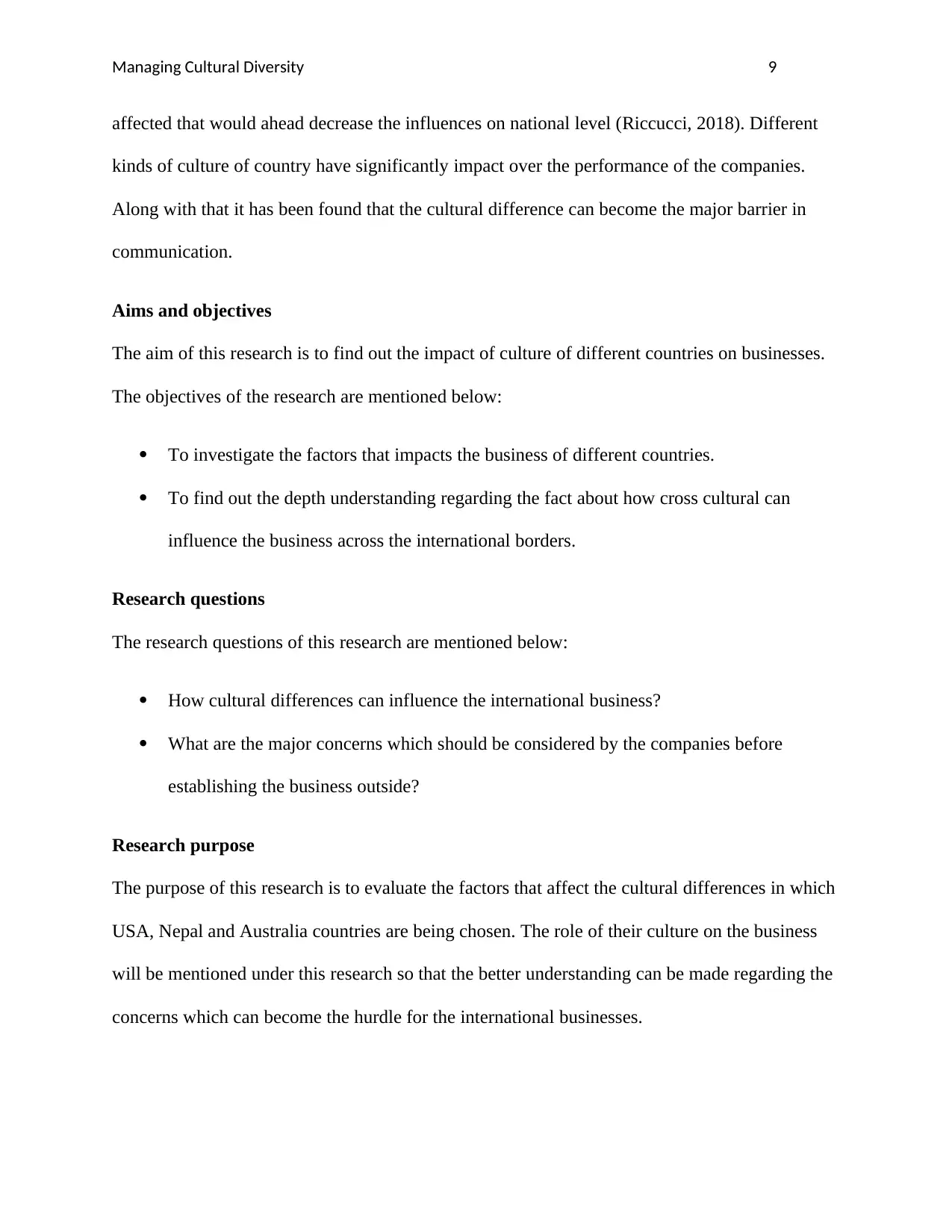
Managing Cultural Diversity 9
affected that would ahead decrease the influences on national level (Riccucci, 2018). Different
kinds of culture of country have significantly impact over the performance of the companies.
Along with that it has been found that the cultural difference can become the major barrier in
communication.
Aims and objectives
The aim of this research is to find out the impact of culture of different countries on businesses.
The objectives of the research are mentioned below:
To investigate the factors that impacts the business of different countries.
To find out the depth understanding regarding the fact about how cross cultural can
influence the business across the international borders.
Research questions
The research questions of this research are mentioned below:
How cultural differences can influence the international business?
What are the major concerns which should be considered by the companies before
establishing the business outside?
Research purpose
The purpose of this research is to evaluate the factors that affect the cultural differences in which
USA, Nepal and Australia countries are being chosen. The role of their culture on the business
will be mentioned under this research so that the better understanding can be made regarding the
concerns which can become the hurdle for the international businesses.
affected that would ahead decrease the influences on national level (Riccucci, 2018). Different
kinds of culture of country have significantly impact over the performance of the companies.
Along with that it has been found that the cultural difference can become the major barrier in
communication.
Aims and objectives
The aim of this research is to find out the impact of culture of different countries on businesses.
The objectives of the research are mentioned below:
To investigate the factors that impacts the business of different countries.
To find out the depth understanding regarding the fact about how cross cultural can
influence the business across the international borders.
Research questions
The research questions of this research are mentioned below:
How cultural differences can influence the international business?
What are the major concerns which should be considered by the companies before
establishing the business outside?
Research purpose
The purpose of this research is to evaluate the factors that affect the cultural differences in which
USA, Nepal and Australia countries are being chosen. The role of their culture on the business
will be mentioned under this research so that the better understanding can be made regarding the
concerns which can become the hurdle for the international businesses.
⊘ This is a preview!⊘
Do you want full access?
Subscribe today to unlock all pages.

Trusted by 1+ million students worldwide
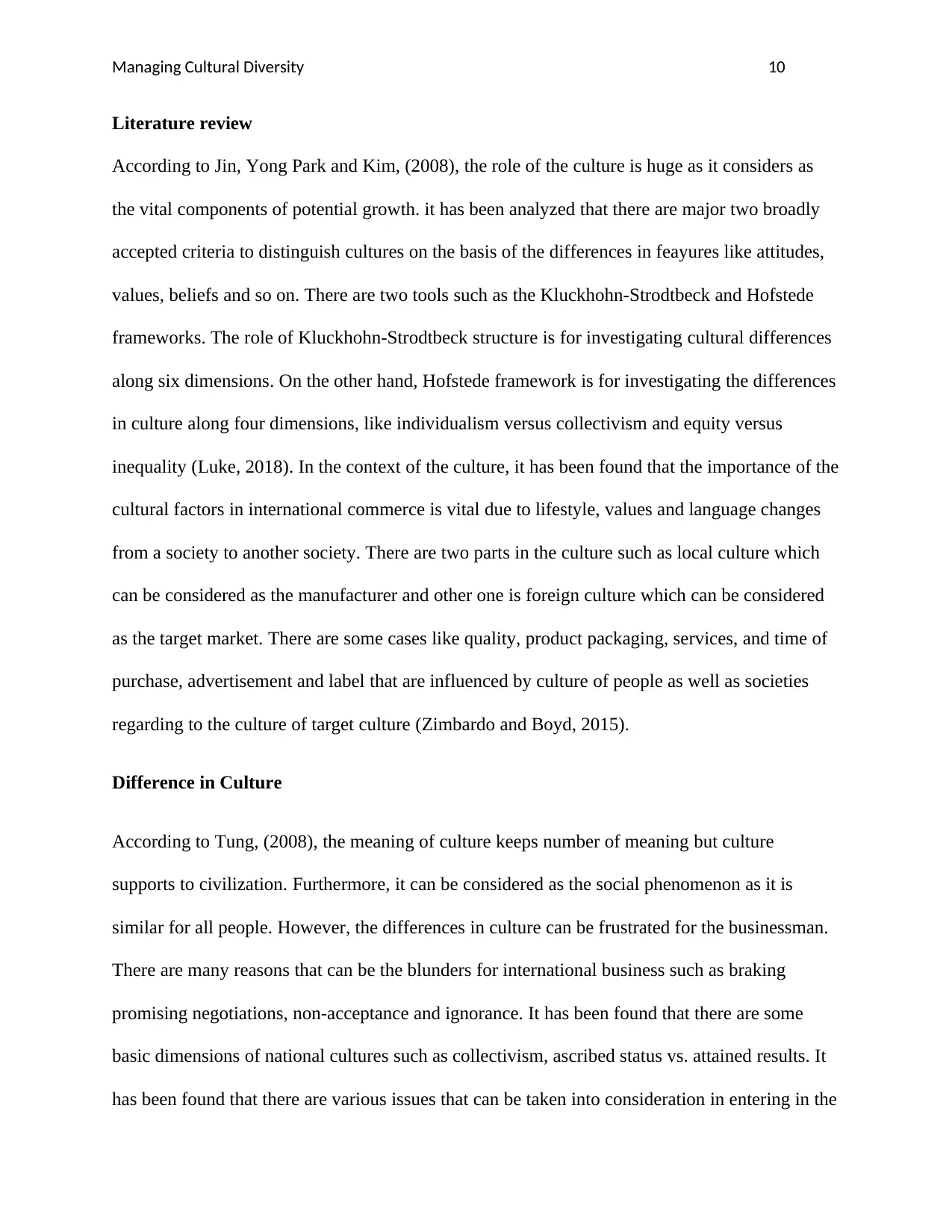
Managing Cultural Diversity 10
Literature review
According to Jin, Yong Park and Kim, (2008), the role of the culture is huge as it considers as
the vital components of potential growth. it has been analyzed that there are major two broadly
accepted criteria to distinguish cultures on the basis of the differences in feayures like attitudes,
values, beliefs and so on. There are two tools such as the Kluckhohn-Strodtbeck and Hofstede
frameworks. The role of Kluckhohn-Strodtbeck structure is for investigating cultural differences
along six dimensions. On the other hand, Hofstede framework is for investigating the differences
in culture along four dimensions, like individualism versus collectivism and equity versus
inequality (Luke, 2018). In the context of the culture, it has been found that the importance of the
cultural factors in international commerce is vital due to lifestyle, values and language changes
from a society to another society. There are two parts in the culture such as local culture which
can be considered as the manufacturer and other one is foreign culture which can be considered
as the target market. There are some cases like quality, product packaging, services, and time of
purchase, advertisement and label that are influenced by culture of people as well as societies
regarding to the culture of target culture (Zimbardo and Boyd, 2015).
Difference in Culture
According to Tung, (2008), the meaning of culture keeps number of meaning but culture
supports to civilization. Furthermore, it can be considered as the social phenomenon as it is
similar for all people. However, the differences in culture can be frustrated for the businessman.
There are many reasons that can be the blunders for international business such as braking
promising negotiations, non-acceptance and ignorance. It has been found that there are some
basic dimensions of national cultures such as collectivism, ascribed status vs. attained results. It
has been found that there are various issues that can be taken into consideration in entering in the
Literature review
According to Jin, Yong Park and Kim, (2008), the role of the culture is huge as it considers as
the vital components of potential growth. it has been analyzed that there are major two broadly
accepted criteria to distinguish cultures on the basis of the differences in feayures like attitudes,
values, beliefs and so on. There are two tools such as the Kluckhohn-Strodtbeck and Hofstede
frameworks. The role of Kluckhohn-Strodtbeck structure is for investigating cultural differences
along six dimensions. On the other hand, Hofstede framework is for investigating the differences
in culture along four dimensions, like individualism versus collectivism and equity versus
inequality (Luke, 2018). In the context of the culture, it has been found that the importance of the
cultural factors in international commerce is vital due to lifestyle, values and language changes
from a society to another society. There are two parts in the culture such as local culture which
can be considered as the manufacturer and other one is foreign culture which can be considered
as the target market. There are some cases like quality, product packaging, services, and time of
purchase, advertisement and label that are influenced by culture of people as well as societies
regarding to the culture of target culture (Zimbardo and Boyd, 2015).
Difference in Culture
According to Tung, (2008), the meaning of culture keeps number of meaning but culture
supports to civilization. Furthermore, it can be considered as the social phenomenon as it is
similar for all people. However, the differences in culture can be frustrated for the businessman.
There are many reasons that can be the blunders for international business such as braking
promising negotiations, non-acceptance and ignorance. It has been found that there are some
basic dimensions of national cultures such as collectivism, ascribed status vs. attained results. It
has been found that there are various issues that can be taken into consideration in entering in the
Paraphrase This Document
Need a fresh take? Get an instant paraphrase of this document with our AI Paraphraser
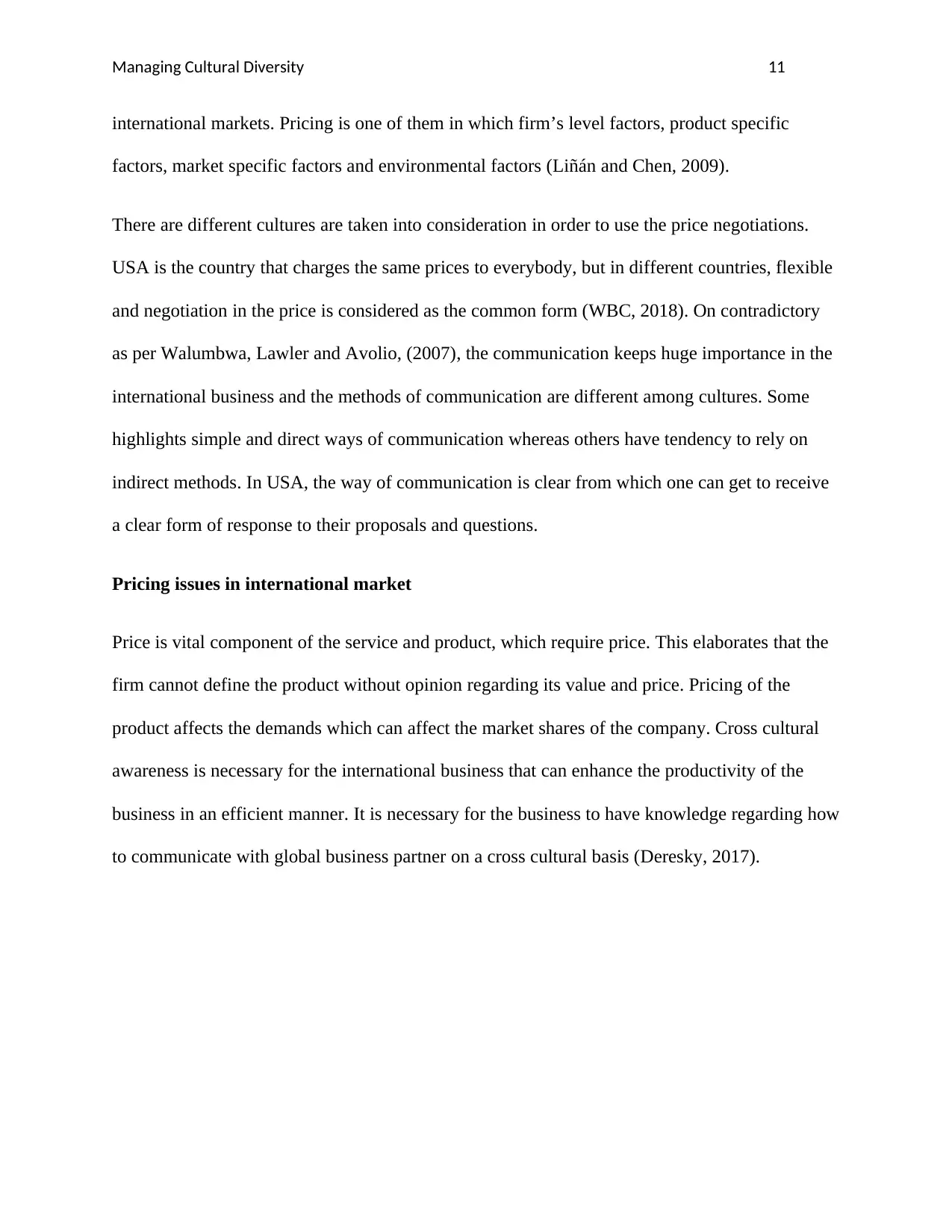
Managing Cultural Diversity 11
international markets. Pricing is one of them in which firm’s level factors, product specific
factors, market specific factors and environmental factors (Liñán and Chen, 2009).
There are different cultures are taken into consideration in order to use the price negotiations.
USA is the country that charges the same prices to everybody, but in different countries, flexible
and negotiation in the price is considered as the common form (WBC, 2018). On contradictory
as per Walumbwa, Lawler and Avolio, (2007), the communication keeps huge importance in the
international business and the methods of communication are different among cultures. Some
highlights simple and direct ways of communication whereas others have tendency to rely on
indirect methods. In USA, the way of communication is clear from which one can get to receive
a clear form of response to their proposals and questions.
Pricing issues in international market
Price is vital component of the service and product, which require price. This elaborates that the
firm cannot define the product without opinion regarding its value and price. Pricing of the
product affects the demands which can affect the market shares of the company. Cross cultural
awareness is necessary for the international business that can enhance the productivity of the
business in an efficient manner. It is necessary for the business to have knowledge regarding how
to communicate with global business partner on a cross cultural basis (Deresky, 2017).
international markets. Pricing is one of them in which firm’s level factors, product specific
factors, market specific factors and environmental factors (Liñán and Chen, 2009).
There are different cultures are taken into consideration in order to use the price negotiations.
USA is the country that charges the same prices to everybody, but in different countries, flexible
and negotiation in the price is considered as the common form (WBC, 2018). On contradictory
as per Walumbwa, Lawler and Avolio, (2007), the communication keeps huge importance in the
international business and the methods of communication are different among cultures. Some
highlights simple and direct ways of communication whereas others have tendency to rely on
indirect methods. In USA, the way of communication is clear from which one can get to receive
a clear form of response to their proposals and questions.
Pricing issues in international market
Price is vital component of the service and product, which require price. This elaborates that the
firm cannot define the product without opinion regarding its value and price. Pricing of the
product affects the demands which can affect the market shares of the company. Cross cultural
awareness is necessary for the international business that can enhance the productivity of the
business in an efficient manner. It is necessary for the business to have knowledge regarding how
to communicate with global business partner on a cross cultural basis (Deresky, 2017).
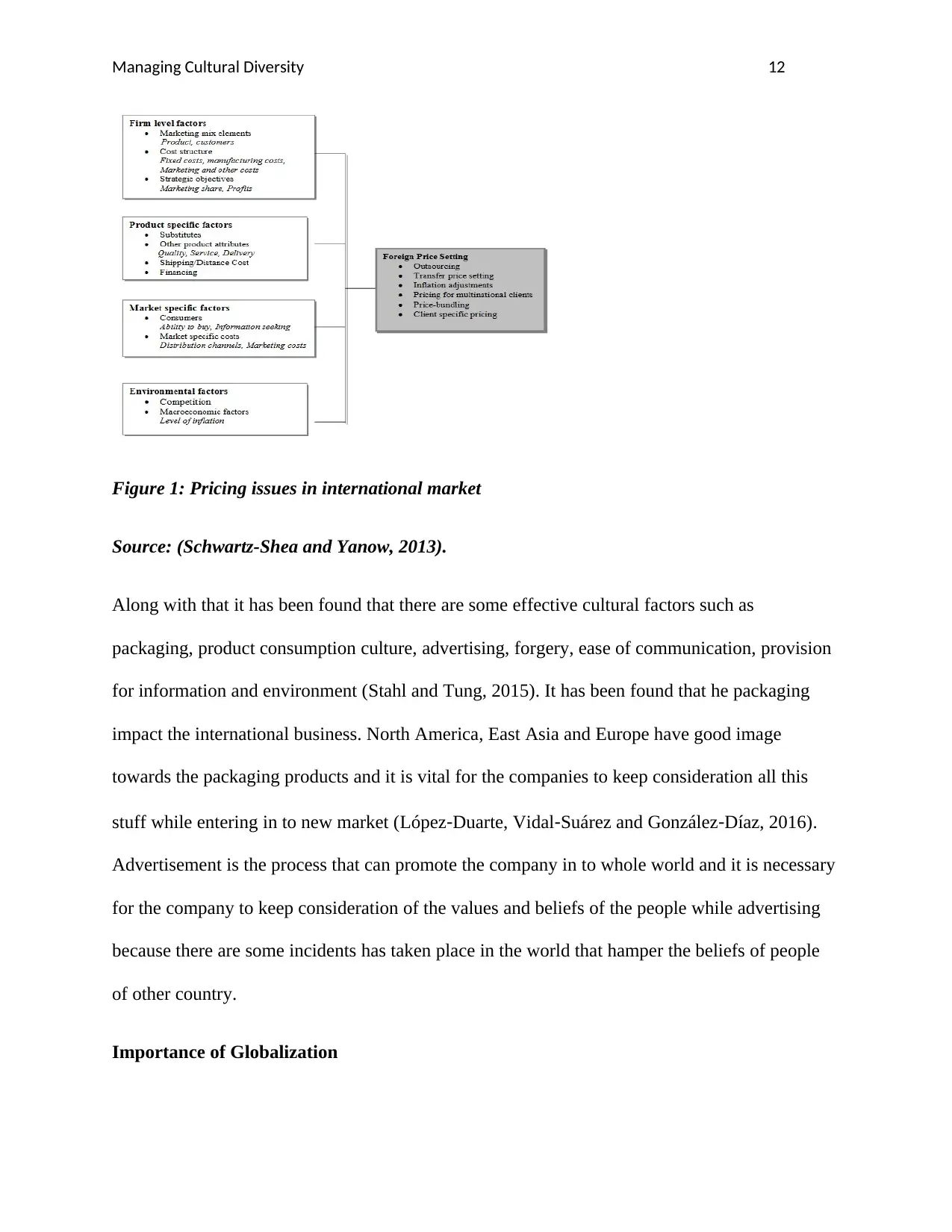
Managing Cultural Diversity 12
Figure 1: Pricing issues in international market
Source: (Schwartz-Shea and Yanow, 2013).
Along with that it has been found that there are some effective cultural factors such as
packaging, product consumption culture, advertising, forgery, ease of communication, provision
for information and environment (Stahl and Tung, 2015). It has been found that he packaging
impact the international business. North America, East Asia and Europe have good image
towards the packaging products and it is vital for the companies to keep consideration all this
stuff while entering in to new market (López‐Duarte, Vidal‐Suárez and González‐Díaz, 2016).
Advertisement is the process that can promote the company in to whole world and it is necessary
for the company to keep consideration of the values and beliefs of the people while advertising
because there are some incidents has taken place in the world that hamper the beliefs of people
of other country.
Importance of Globalization
Figure 1: Pricing issues in international market
Source: (Schwartz-Shea and Yanow, 2013).
Along with that it has been found that there are some effective cultural factors such as
packaging, product consumption culture, advertising, forgery, ease of communication, provision
for information and environment (Stahl and Tung, 2015). It has been found that he packaging
impact the international business. North America, East Asia and Europe have good image
towards the packaging products and it is vital for the companies to keep consideration all this
stuff while entering in to new market (López‐Duarte, Vidal‐Suárez and González‐Díaz, 2016).
Advertisement is the process that can promote the company in to whole world and it is necessary
for the company to keep consideration of the values and beliefs of the people while advertising
because there are some incidents has taken place in the world that hamper the beliefs of people
of other country.
Importance of Globalization
⊘ This is a preview!⊘
Do you want full access?
Subscribe today to unlock all pages.

Trusted by 1+ million students worldwide
1 out of 27
Related Documents
Your All-in-One AI-Powered Toolkit for Academic Success.
+13062052269
info@desklib.com
Available 24*7 on WhatsApp / Email
![[object Object]](/_next/static/media/star-bottom.7253800d.svg)
Unlock your academic potential
Copyright © 2020–2025 A2Z Services. All Rights Reserved. Developed and managed by ZUCOL.





